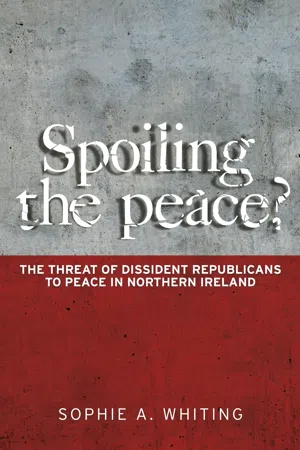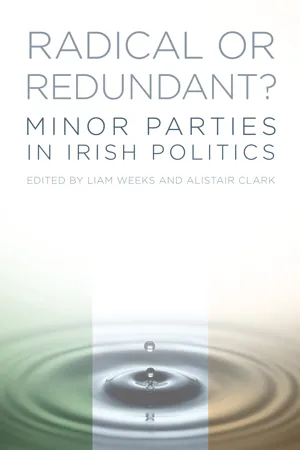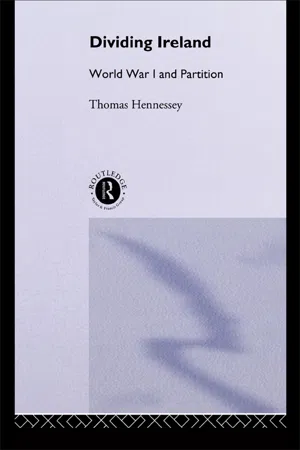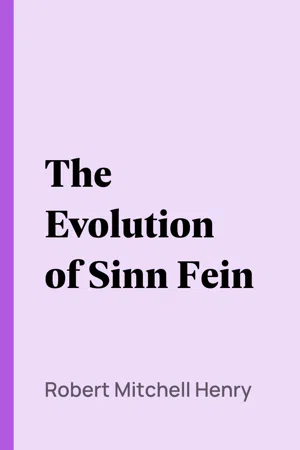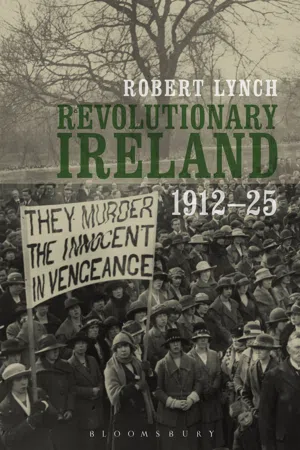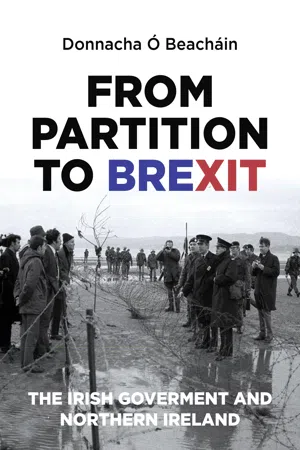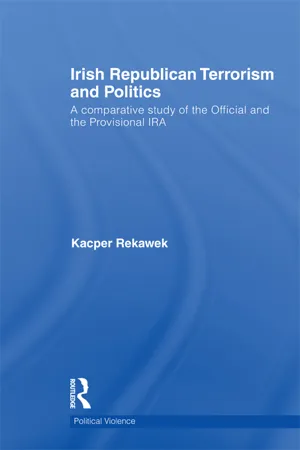Politics & International Relations
Sinn Féin
Sinn Féin is an Irish republican political party that advocates for the reunification of Ireland and has historically been associated with the Irish Republican Army (IRA). It has evolved from a fringe party to a major force in Irish politics, particularly in Northern Ireland. Sinn Féin's platform includes policies on social justice, Irish language rights, and anti-austerity measures.
Written by Perlego with AI-assistance
Related key terms
11 Key excerpts on "Sinn Féin"
- eBook - ePub
Spoiling the peace?
The threat of dissident Republicans to peace in Northern Ireland
- Sophie Whiting(Author)
- 2015(Publication Date)
- Manchester University Press(Publisher)
Changes within Sinn Féin have involved the broadening of ideas (such as a more pluralist conception of identity), the rearranging of principles (equality has been frontloaded ahead of freedom, with self-determination and territorial sovereignty demoted in favour of a vaguer ‘Ireland of Equals’), a change of tactics (full movement into constitutional politics) and the relegation of imperatives (British withdrawal and a united Ireland) to aspirational ultimate objectives, albeit still prominent in Sinn Féin discourse. The sum of these parts is considerable transition. Yet, no representation of republicanism across the broad spectrum would deny that the tradition is evolutionary and contextual. Ultimately, it is unrealistic to expect political parties to remain static over time and unchanged in policies. When bound by laws of electoral competition (as Sinn Féin became) with office-seeking priorities, parties have to respond, to external (e.g. electoral, governmental) and internal (e.g. incentives to achieve tangible results) pressures that develop. The academic literature that considers the evolution of Sinn Féin is wide-ranging in assessing the impact of military fortune and British state strategy, but has appeared reluctant to comprehend Sinn Féin as essentially an ordinary political party in modern times, conditioned by the rules of the electoral game and successfully adapting to those rules.Sinn Féin appears in a position of dominance in their representation of the republican tradition. Such a position is testament to the overall success of the rebranding of the party. As a result, the party is often portrayed as standing as the mouthpiece or the single representation of the Irish republican tradition, possessing the republican franchise. Other groups and individuals who claim to represent republicanism are considered in relation to what Sinn Féin represent. As McGovern observes, ‘it is necessary to understand the extent to which Sinn Féin has successfully recast itself as the primary political mouthpiece for this complex northern Nationalist outlook. In doing so they have rearticulated the meaning of Republicanism.’121 - eBook - ePub
Radical or Redundant?
Minor Parties in Irish Politics
- Liam Weeks(Author)
- 2011(Publication Date)
- THP Ireland(Publisher)
3This chapter builds on this nascent work. We are interested primarily in the party as an electoral organisation in the Republic of Ireland, although we also make references to its operation in Northern Ireland. We first explore the roots and history of the party, its growth strategies, policies, support bases and organisation in order to decide how best Sinn Féin’s role in the Irish political party system can be understood. We conclude that its policies are broadly left of centre and its nationalism has undergone a transformation in line with the transformation of the situation in Northern Ireland. There is a strong potential for growth as Sinn Féin builds a grassroots-based campaigning organisation that targets the socially marginalised and young people. It may also benefit from being seen as the main opposition party (as Fianna Fáil struggles to criticise the Fine Gael–Labour coalition’s policies due to its central role in the economic crisis). However, Sinn Féin also faces challenges as it seeks to move the leadership of the party from the charismatic old guard to a new younger grouping and to maintain consistency north and south of the border in radically different contexts in order to fulfil its own claim to be an all-Ireland party.Roots of the party
While Sinn Féin (variously translated as ‘Ourselves’, inelegantly as ‘We Ourselves’ or incorrectly as ‘Ourselves Alone’) was founded in 1905 by the non-violent nationalist, Arthur Griffith, it has split so many times that practically all political parties in Ireland (and none) can claim to be descended from this original party. Sinn Féin was a small, insignificant party in Ireland until, following the 1916 Easter Rising, it reconstituted as a broad nationalist party, having become the focus for the electoral efforts of the unsuccessful military revolt. The British wrongly assumed Sinn Féin had been behind the uprising. Before that it was a nationalist party looking for a joint-sovereignty arrangement to achieve similar terms to Hungary in the Austro-Hungarian Empire. In the December 1918 general election it received 47 per cent of the vote on the whole island, and had all the seats been contested would probably have received two-thirds of the vote (Sinn Féin won twenty-five seats without a contest).4 - eBook - ePub
Dividing Ireland
World War One and Partition
- Thomas Hennessey(Author)
- 2005(Publication Date)
- Routledge(Publisher)
Within the broad church that was the post-1916 Sinn Fein movement, there existed deep divisions regarding the final relationship that a self-governing Ireland should have with the British Empire and Crown, divisions so deep that ultimately, it can be argued, they provided the foundations for the Anglo-Irish Treaty split in 1921 and the subsequent Irish Civil War of 1922– 23. Sinn Fein was a coalition of extreme and moderate Nationalists who, at the leadership level, were united in their ideological commitment to a Gaelic-speaking Ireland, but were divided between those who were prepared to accept some form of Irish monarchy and those who wished to establish an Irish republic. The Easter rebels, constituting themselves the Provisional Government of the Irish Republic, had declared in the Proclamation of the Republic:We declare the right of the people of Ireland to the ownership of Ireland, and to the unfettered control of Irish destinies, to be sovereign and indefeasible. The long usurpation of that right by a foreign people and government has not extinguished the right, nor can it ever be extinguished except by the destruction of the Irish people…we hereby proclaim the Irish Republic as a Sovereign Independent State…. The Irish Republic is entitled to, and hereby claims, the allegiance of every Irishman and Irishwoman. The Republic guarantees religious and civil liberty, equal rights and equal opportunities to all its citizens, and declares its resolve to pursue the happiness and prosperity of the whole nation and of all its parts, cherishing all the children of the nation equally, and oblivious of the differences carefully fostered by an alien government.However, republicanism represented but one strand of advanced nationalism. A second strand supported the retention of the monarchical principle. Sinn Fein supporters of an Irish monarchy were, however, divided between those who wished to see a self-governing Ireland possessing the status of an Irish Dominion within the emerging British Commonwealth of Nations, and those who wished to see the re-establishment of the Kingdom of Ireland which had existed before the Anglo-Irish Union. All Sinn Feiners were, however, united in their belief that their first loyalty was to Ireland and Ireland alone. This position was set out by Darrell Figgis in the Sinn Fein Catechism, which explained it in the form of a series of questions and answers: - eBook - ePub
- Robert Mitchell Henry(Author)
- 2010(Publication Date)
- Perlego(Publisher)
There is hardly a writer in Ireland to-day of any promise in either prose or verse who does not owe a heavy debt to the work of the Gaelic League. The Gaelic League proceeded upon the assumption that Irishmen possessed and ought to possess an interest in the language of their own country. It did not argue the point or indulge in academic discussions upon the utility of Gaelic as a medium of communication or upon the psychology of language. Its simple appeal to a natural human feeling found a response wider than could have been evoked by a learned controversy or effected as the fruit of a dialectical victory. But language is only a part of nationality and the attachment of a human being to the language of his country is only a special case of his attachment to the nation. This, though the Gaelic League held aloof from all politics (in the narrow sense of the word), is what gave to the work of the Gaelic League a real political importance. The stimulation of national sentiment in one department gave a stimulus to the same sentiment in other departments, and the new and vigorous national sense which it fostered was bound to lead sooner or later to expression in political action. But even after this political activity began to be manifest, the League confined itself to its original work, and held as much aloof from politics infused by its own spirit as from the forms of political action which held the field when its work began. Sinn Fein is an expression in political theory and action of the claim of Ireland to be a nation, with all the practical consequences which such a claim involves. It differs from previous national movements principally in the policy which it outlines for the attainment of its ultimate end, the independence of Ireland: though it should be understood that nearly every point in the Sinn Fein political programme had been at least suggested by some previous Irish Nationalist thinker - eBook - ePub
Rebels in government
Is Sinn Féin ready for power?
- Agnès Maillot(Author)
- 2022(Publication Date)
- Manchester University Press(Publisher)
1The United Ireland party
We’re Irish republicans. We’re passionate about Irish unity, it’s what we get up in the morning to try and achieve. (Pearse Doherty, YouTube, 05/07/20 )In 2018, when asked what the Good Friday Agreement (GFA) fundamentally meant, Gerry Adams gave a puzzling assessment: in his view, it ‘doesn’t pretend to be a settlement. It is an agreement on a journey, without agreement on the destination’ (Adams, YouTube, 10/04/18 ). For anyone with any knowledge about Sinn Féin, however, this destination was very clear: the unification of Ireland, which is what has driven, and justified, the party’s existence. This makes Sinn Féin a unique political organisation within Ireland, one that has a vision to which it has held steadfastly, one that can look beyond the ordinary mandate and present a utopian project. Furthermore, no other party is fully organised on both sides of the island, with the exception of small, fringe organisations that had not, as of the early 2020s, made any significant breakthrough into the Irish political scene. Sinn Féin is determined to provide a roadmap for the long-term future of the island. Reshaping the economy, remodelling society, and redressing inequalities, are all intertwined in the process that the party and its followers embarked upon a century ago and that, in spite of many setbacks and divisions, is still seen as the top priority.Irish unity: a fundamental ideal, a fluctuating strategy
Dublin-based journalist Arthur Griffith would probably fail to recognise the current party as the latest incarnation of the movement known as Sinn Féin, which he founded in 1905. The main ingredient it has retained is also one of its most symbolic, and radical, strategies: abstentionism, which is still in place for Westminster elections, and in practice means that no elected Members of Parliament will take their seats in the House of Commons. The historical ties have thus not been entirely severed, as the logic that applied to this tactic in the early twentieth century is still considered valid today: that of refusing to recognise the authority of the UK, then the British Empire, over Ireland. Of course, historical and political conditions changed considerably throughout the twentieth century. Sinn Féin adapted its demands to the context in which it was operating, shifting its focus from the quest for self-determination until 1921, to the removal of the oath of allegiance1 - eBook - ePub
British Elections & Parties Review
The 2001 General Election
- Lynn G. Bennie, Colin Rallings, Jonathan Tonge, Paul Webb(Authors)
- 2012(Publication Date)
- Routledge(Publisher)
Sinn Fein demanded further changes in policing, with full implementation of the Patten Report constituting the minimum demand. Sinn Fein’s electoral strategy, emphasizing support for the Good Friday Agreement, was always likely to pay dividends among an electoral base strongly favouring the accord and desirous of robust political representatives. Committed to its peace strategy, Sinn Fein had long moved from its early electoral position of the 1980s, when its and fheis (annual conference) instructed all candidates to declare unequivocal support for the IRAs armed struggle. With that phase of conflict apparently over, the party, while emphasizing its continuing republican objectives, offered a participatory form of politics contrasting sharply with the support for the armed destruction of the state favoured in previous eras. According to republican critics of Sinn Fein’s changed approach, the party’s electoral success could not disguise the failure of the party to achieve its objective of a united Ireland, now displaced by participation within a Northern Ireland state previously held as illegitimate (McIntyre, 2001). Sinn Fein’s manifesto asserted that the Good Friday Agreement ‘transcends partition’ (Sinn Fein, 2001: 6). However, this claim was ranged against the Agreement’s assertion that Northern Ireland remained part of the United Kingdom, for so long as the people of Northern Ireland so choose. As such, the Agreement was clearly partitionist, at least in the short and medium terms. Electoral imperatives appeared to have displaced ideological purity, exemplified by the decision of Sinn Fein to enter Stormont, without any realistic prospect of a united Ireland, or even joint British–Irish authority (Hazleton, 2001) - eBook - ePub
- Robert Lynch(Author)
- 2015(Publication Date)
- Bloomsbury Academic(Publisher)
The ambiguity of the Home Rule party’s response to the Rising was understandable and to a large extent reflected that of the Nationalist constituency it claimed to represent. The old certainties evaporated as new organisations and initiatives rose to populate the new political landscape. Many saw the chance to reflect this nebulous sense of advanced nationalism in a variety of new ways. One example of this was the Irish Nation League which while having the defined goal of representing those border counties which were to be excluded from the home rule remit, demonstrated a concrete example of a different and more advanced Nationalist political vision. The fact that this party would soon crumble and be subsumed within the Home Rule party machine did little to restore faith that the troublemakers were now inside the tent. In a thousand similar ways of personal and organisational initiative the old certainties of the monolithic Home Rule party began to crumble. Although eventually these early challengers would succumb to the dominance of the Home Rule party they would offer a chance for many people to dip their toe into the previously marginalised and discredited waters of advanced nationalism and even republicanism, presenting a bridge over which so many people would flock once the new Sinn Fein movement emerged and offered an alternative destination. In short it was clear that disillusionment with the ‘old politics’ of the Home Rule party long preceded the existence of a political alternative to articulate it.The birth of Sinn Fein
While the Home Rule party was finding it difficult to exploit the new flexibility which had gripped Irish nationalism, the movement that would soon come to replace it and dominate Irish politics was faring little better in adapting to the new fluid situation. Sinn Fein, less a political party than a half-mocking label for any Nationalist left of the Home Rule party, came to be associated with the Rising as the only credible catch-all name which was associated with advanced nationalism and crucially the only open organisation which had any set of articulate, if rather quirky, political demands. With Griffith, the key personification of these ideas, in gaol other figures began to try and build a movement utilising the Sinn Fein brand name. The beginnings of the new movement were not auspicious. In Griffith’s absence, Hubert Moore-Pym was left in temporary charge. Pym, who hailed from an Orange Protestant background, did a great deal to upset his colleagues and potential allies with his abrasive style and peculiar ideas, eventually leaving to resume his career as an unreconstructed Ulster Unionist. Even without Pym, the ideological base of the party was out of kilter with that of the Easter rebels, still running on a dual monarchist platform and an idealisation of the Austro-Hungarian Empire, which was ironically falling to pieces under the pressures of war and the impact of ethnic nationalism. However, in Griffith’s absence the new activists did at least cement the link that Sinn Fein had in the popular imagination with the Rising. Through the publication of a newspaper they also encouraged, or at least did not discourage, those who were disillusioned with more traditional forms of constitutional nationalism to find a home in the party by painting it as the only coherent alternative. Even so the aftermath of the Rising presented far more confusion and ambiguity than political coherence. While it may be argued that a sea change was taking place within Irish nationalism amongst its supporters in favour of a more advanced alternative, there was little tangible evidence of this in the shape of new practical political outcomes. - eBook - ePub
Seán MacDiarmada
16Lives
- Brian Feeney(Author)
- 2014(Publication Date)
- The O'Brien Press(Publisher)
The Sinn Féin Policy . To advanced nationalists it seemed that the Irish-Ireland movement now had a viable political programme and to top it off the programme even had a name in Irish – Sinn Féin or ‘We Ourselves’, almost the same as the motto of the Gaelic League. Those who supported the Sinn Féin policy did not see themselves as a political party at this stage, but were more a pressure group trying to influence IPP policy.Griffith made his speech to the annual convention of the important-sounding National Council, which he had set up with others in Dublin in 1903 to coordinate protests against the visit to Ireland of the new king, Edward VII. The National Council had taken on a life of its own and branches had been established in Belfast, Cavan, Kilkenny, Waterford and Cork by September 1906. However, despite its name the National Council was far from a ‘national’ organisation. In reality it was one of a number of vociferous pressure groups based in Dublin and run by advanced nationalists like Griffith who wanted to persuade the IPP to consider an alternative approach to the national question. The historian FSL Lyons described Dublin at the time as being full of ‘a multitude of little clubs’. Apart from the National Council, these included branches of Cumann na nGaedheal and the women’s equivalent, Inghinidhe na hÉireann (Daughters of Ireland). Many people were members of two or three different clubs, political, literary or cultural.It was no accident that Griffith launched his Sinn Féin policy when he did, just two months before the 1906 general election, to try to put maximum pressure on the IPP. His initiative had no effect on the election as the IPP ignored him, his organisations and his newspaper. The party received its usual massive endorsement of the Home Rule policy from the Irish electorate only to find that this time the Liberal majority rendered them powerless. - eBook - ePub
From Partition to Brexit
The Irish Government and Northern Ireland
- Donnacha Ó Beacháin(Author)
- 2018(Publication Date)
- Manchester University Press(Publisher)
One future party leader, Alisdair McDonnell, for example, confided that the New Ireland Forum was ‘the last chance for constitutional nationalism in Northern Ireland’ and that if it failed, SDLP members like him would face ‘the stark choice of continuing on the constitutional path or joining forces with Provisional Sinn Féin’. 113 With the advent of the New Ireland Forum, John Hume and his party acolytes would be transported from the periphery of British politics to the centre of Irish policy making on the national question, debating and negotiating on equal terms with the leaderships of the three larger parties in the Republic. Though the Forum was designed ostensibly to alleviate nationalist alienation in Northern Ireland it explicitly excluded representatives of what was arguably the most disaffected section of northern society, those who had never voted before but in 1982 had cast a ballot for Sinn Féin. The credibility of the Government's Northern Ireland policy necessitated the marginalisation of Sinn Féin. With the SDLP in the ascendancy, Dublin could claim to be articulating the views of northern nationalists but should Sinn Féin overtake them the Taoiseach would be enunciating a position at odds with both the majority of unionists and the majority of nationalists in Northern Ireland. As the British ambassador to Ireland reported back to his superiors in London: I do not believe there is much instinctive horror of Sinn Féin outside sophisticated circles in the South, any more than there is in a wide range of the Northern Catholics. It is this range of feelings that inspires in the Irish Government the fear that Sinn Féin are set, both in the North and in the South, to achieve further political advances - eBook - ePub
New Sinn Féin
Irish Republicanism in the Twenty-First Century
- Agnès Maillot(Author)
- 2004(Publication Date)
- Routledge(Publisher)
With the peace process, this phrase lost its currency in republican discourse. Indeed, it has possibly impaired the party’s efforts to present itself as the ‘party of equals’. But achieving recognition for its work as the party of ‘the man of no property’, to use James Connolly’s expression, was going to take more than a slogan. Other, more pragmatic, strategies were used to establish Sinn Féin’s credentials. In the 1980s new expressions started to emerge, and were included in Sinn Féin’s repertoire, such as ‘community work’, ‘people empowerment’ and ‘local democracy’. These concepts were soon to become the cornerstone of the strategy on which Sinn Féin was to successfully widen its appeal. In order to implement it, the party was to use to its advantage what had been perceived until then as an obstacle to its aspiration to become a relevant political party: its marginalisation from the mainstream political process. Indeed, Sinn Féin had gathered invaluable experience in working in an alternative political mode, by getting involved on the ground, setting up its own network of clinics and advice centres, and creating links with the voluntary groups that were emerging in the 1980s in Northern Ireland.Sinn Féin’s goal was to foster participative democracy; in other words, to bring power back to the people. This philosophy was exposed in a policy document published in 1998, Putting People First , which outlined the party’s commitment to devolving the decision-making process to local communities, because ‘to do otherwise merely leaves intact the structures, which inevitably recreate economic and social inequalities and the continued exclusion of communities from decision-making which affect their lives’ (1998: 1). Its experience as a campaigning party was something that it could draw upon to put this vision into practice, since it enabled Sinn Féin activists to present themselves as the people who got things done. Its long tradition of street protest, inherited from years of being less a political party and more a machine to mobilise supporters, proved to be a powerful asset when it came to entering the electoral arena. Thus, the party was able to implement lessons learned from campaigns that were very different in scope but similar in strategy. Some of these were highly successful, such as the hunger strike campaign which, at its height, mobilised thousands of people across the island. Others were more modest, but they also used the same techniques of marches, petitions, demonstrations and fund-raising events, such as the Stop the Strip Searches, or the anti-extradition campaigns in the mid- to late 1980s. All had a common feature, which was retained in future campaigns: they emanated from groups which were close to the party but which kept a level of independence, and which were created with one specific aim and one specific demand. The National H-blocks Armagh Committee was set up by relatives of the prisoners and was not, strictly speaking, a Sinn Féin-led movement. The distinction was deemed important by republicans. Although few doubted that these groups were fronts for Sinn Féin, and although some people even condemned the manner in which they were exploited by Sinn Féin, they maintained sufficient distance from the party to enable those who were not entirely comfortable with the ideas or strategies associated with the republican movement to get involved in the campaigns. Thus, when the parades issue came to the fore in Northern Ireland in the mid-1990s, several residents’ associations were put in place. A closer look at the composition of these associations would tend to show that, on the whole, their spokespersons were affiliated to Sinn Féin in one way or another (see Chapter 6 - eBook - ePub
Irish Republican Terrorism and Politics
A Comparative Study of the Official and the Provisional IRA
- Kacper Rekawek(Author)
- 2011(Publication Date)
- Routledge(Publisher)
Its ‘unhealthy’ character was fully evident during PSF's attempts to strengthen its island-wide appeal and duplicate its party of government or party of government-in-waiting role that it enjoyed in Northern Ireland. However, the tag of the Northern party led almost along military lines effectively based in another country had serious limitations. PSF faced a sizeable difficulty while trying to repeat this success in the Republic of Ireland. ‘Dissenting’ Provisional republicans would describe the PSF as beingin a political cul de sac [from which] it is going to be very difficult … to progress. In many ways, this is indicative of what republican sort of adventures into Southern politics have always been like … Republican politics down there … they tend to be swallowed up by the bigger parties and that's exactly what has happened to [P]SF. For [P]SF to flourish, there needs to be a vacuum in which the electorate are dispossessed in some way.(O'Rawe 2007)According to this analysis, PSF could not count on great electoral advances as long as the Republic of Ireland, ‘a very unequal society’, still ‘works’ (McDonald 2008a). In such circumstances PSF's slogan of ‘building Ireland of equals’ and ‘building a true democracy, where both political and economic power is distributed as widely as possible – an Ireland based on equality, justice, rights and empowerment’, could not provide the party with more electoral advances (Sinn Fein 2001b). However, this was partly contradicted during the 2004 local and European elections when the party gained thirty-three new councillors in the Republic of Ireland, and saw the election of its first ever Members of the European Parliament (MEPs), one in the Republic and one in Northern Ireland. This was of course hailed as yet another transformation of the political landscape. It also remains to be seen how well the party will fare in the next parliamentary election in Ireland which will take place in 2011. In theory, the effects of the global economic crisis in Ireland should favour the antiestablishment party of the radical left, as PSF styles itself to be in the Republic of Ireland, but in practice the bigger Fine Gael and ILP, traditional coalition partners, might reap most of the protest electoral gains by offering a more plausible governmental arrangement after the election than the relatively young antisystemic political upstart led by Gerry Adams.
Index pages curate the most relevant extracts from our library of academic textbooks. They’ve been created using an in-house natural language model (NLM), each adding context and meaning to key research topics.
